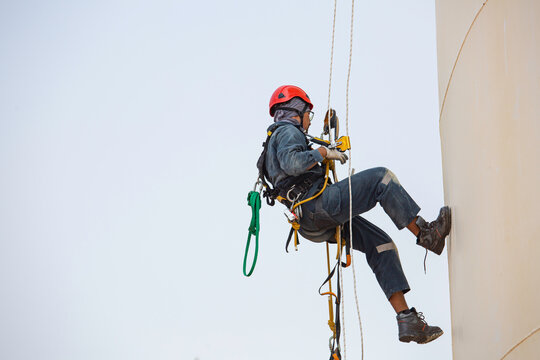Uncategorized
Rope Access: The Key to Safe and Efficient High-Rise Operations
Rope access is an essential technique used for maintenance, repairs, and inspections on tall structures like high-rise buildings, bridges, and offshore platforms. While it offers numerous advantages in terms of cost, flexibility, and efficiency, the safety of workers in these environments is paramount. Whether you’re a rope access technician, a safety supervisor, or involved in height-related operations, understanding the safety standards, best practices, and procedures is crucial. This article will explore the key elements of rope access safety, including equipment, techniques, and training, to ensure that operations are carried out efficiently and without incident.
Why Rope Access Safety Matters
Rope access involves working at great heights in dynamic and challenging environments. Given the inherent risks, implementing proper safety protocols is crucial. Accidents can lead to severe injuries or fatalities, emphasizing the importance of stringent safety measures in rope access operations. Not only is ensuring worker safety a legal requirement, but it is also a moral obligation. The implementation of effective safety standards can significantly reduce the chances of accidents.
Essential PPE for Rope Access Technicians
Personal protective equipment (PPE) is the first line of defense in protecting workers at height. Here are the essential PPE items that every rope access technician should use:
- Harnesses: The primary piece of equipment connecting the technician to the rope system. Proper fit is essential to ensure comfort, stability, and support in the event of a fall. Regular inspections are crucial to detect signs of wear and tear.
- Helmets: Helmets protect the head from falling debris and impacts. They must be worn at all times and regularly inspected for cracks or damage.
- Gloves: Providing protection for the hands, gloves should offer dexterity and abrasion resistance. Inspect gloves frequently for damage and replace when necessary.
- Safety Boots: Slip-resistant soles ensure stability, and reinforced toes protect against impacts. Boots must be durable and provide proper support during operations.
- Safety Glasses: Protect eyes from debris, dust, or particles. Impact-resistant lenses are a must, and they should be regularly cleaned and inspected for damage.
Rope Access Techniques: How to Work Safely at Heights
Rope access technicians rely on several key techniques to minimize risks while performing tasks at height:
- Rope Handling: Proper rope handling prevents tangling and damage. Rope protectors and edge guards can minimize wear when passing over sharp edges.
- Anchor Point Selection: Correctly assessing anchor points ensures the stability of the entire rope system. Anchor points should be strong, secure, and capable of withstanding the loads expected during operations.
- Knot Tying: Knot tying is essential to secure the rope system. Technicians must regularly practice knot tying to maintain proficiency and prevent accidents.
- Communication Protocols: Effective communication between technicians and supervisors is critical. Using hand signals, radios, or other methods ensures that everyone is aware of potential hazards and changes in the work environment.
- Safety Checks: Technicians must perform continuous safety checks on their harnesses, ropes, and anchor points. Any signs of wear or damage should be reported immediately.
Emergency Procedures and Rescue Techniques
Despite rigorous safety measures, emergencies can still occur. A prepared rescue plan is crucial for minimizing response times. Here’s what an emergency plan should include:
- Emergency Readiness: Technicians should be familiar with emergency procedures, including knowing the location of exits, assembly points, and first aid facilities.
- Communication During Emergencies: In emergencies, clear communication is key. A reliable communication system ensures workers can relay critical information quickly.
- Evacuation Plans: Site-specific evacuation plans should include safe routes and designated anchor points for rescue.
- Rescue Techniques: Technicians must be trained in rescue operations, which may involve ascending or descending to rescue a stranded worker or using specialized equipment.
- First Aid and Medical Support: Ready access to first aid kits and medical support is essential, and workers should be trained in basic first aid.
Training and Certification for Rope Access Technicians
Proper training and certification are vital for rope access technicians. Certification programs are available at multiple levels, from beginner to advanced. Key aspects of rope access training include:
- Certification Levels: Technicians progress through levels as they gain experience and demonstrate proficiency in essential skills.
- Ongoing Education: The rope access industry evolves, and technicians must stay current with the latest practices and standards.
- On-the-Job Experience: Hands-on experience is necessary for technicians to apply their training in real-world settings.
For businesses that want to improve their operational processes, business consulting could be a great option. Such services can streamline operations and help improve efficiency in the long term.
The Future of Rope Access
The demand for rope access services is increasing in industries like construction, oil and gas, and renewable energy. Innovations in safety gear, such as advanced fall protection systems, and improved rescue technologies, will continue to shape the future of rope access. With ongoing research and collaboration among industry stakeholders, safety and efficiency will remain at the forefront of rope access operations.
To stay at the forefront of rope access technology, companies should invest in the best quality rope access gear available. Quality equipment ensures safety and boosts operational efficiency.
Conclusion
rope access offers a highly efficient and safe solution for working at heights, provided safety protocols are rigorously followed. By ensuring proper training, certification, and the use of high-quality personal protective equipment, workers can minimize risks and enhance operational efficiency. Ongoing education and adherence to best practices, including proper rope handling, anchor point selection, and communication, are crucial for maintaining a safe working environment. As the industry continues to evolve, staying up to date with innovations in equipment and techniques will ensure that rope access remains a reliable and safe choice for high-rise operations.

